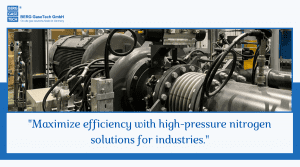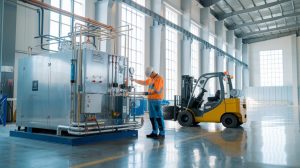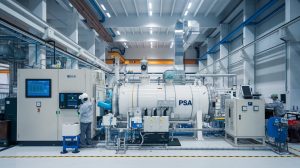Nitrogen generators have changed industries that rely on inherent nitrogen generation by providing a cheap and efficient source of high-purity Nitrogen when needed. These devices help eliminate standard nitrogen cylinders, thus improving efficiency in automobile manufacturing, plane building, and other industries. As this blog indicates, nitrogen generators improve tyre performance, optimize industry processes, and reduce environmental impact.
Understanding Nitrogen Generators
Nitrogen generators are devices engineered to extract Nitrogen from the air and dispense it at a required degree of purity. They use sophisticated technologies like Pressure Swing Adsorption (PSA) and membrane filtration to do this in a quasi-cheap fashion.
Key Technologies Used in Nitrogen Generators
- Pressure Swing Adsorption (PSA):
PSA technology passes gasses through carbon molecular sieves, which selectively adsorb oxygen and other elements while Nitrogen is released. This method is widely used for that very reason: they are accurate and reliable. - Membrane Filtration:
In this method, compressed air is used to keep the nitrogen molecules separated from oxygen and the other components through a semipermeable membrane. Membrane systems are ideally suited to applications where a moderate degree of nitrogen purity is demanded.
These technologies have offered nitrogen generation as a realistic and viable solution for several purposes, from inflating tyres to manufacturing.
Applications of Nitrogen Generators
They have become trendy in many industries below. Their usefulness crosses diverse environments, which is highlighted below.
1. Nitrogen Generators for Tires: Nitrogen-inflated tyres have advantages over conventional pneumatic tyres, hence their use in pneumatic sectors such as automotive and aerospace.
- Automotive Industry:
Nitrogen does not allow for faster dissipation of pressure, so tyres maintain pressure at a given interval of time. Just as importantly, the hose keeps them in usable shape while also increasing fuel economy and safety. - Aviation Sector:
Companies with nitrogen generator for tires ascertain that airplane tyres will perform well and be reliable. Inflation with NitrogenNitrogen: the reversibility of pressure changes due to temperature and altitude, which is critical for flights.
2. Industrial Nitrogen Generators: In industrial settings, a continuous supply of nitrogen with very low levels of contamination is typically needed in processes that are best performed in an inert atmosphere.
- Food and Beverage Industry:
Nitrogen is used in food industries to replace oxygen, helping to preserve foods and increase their shelf life. - Electronics Manufacturing:
In the manufacture of semiconductors and circuit boards, nitrogen helps to avoid oxidation during soldering and assembly, which enhances product quality. - Chemical Processing:
It is used to make unreactive or eliminate and reduce conditions conducive to fire and contamination within chemical processes.
3. Industrial Oxygen Generators: Nitrogen generators are widely used, but oxygen generators also have a significant role in industrial use.
- Metal Fabrication:
From the table above, oxygen contributes to welding, cutting and brazing by maintaining the desired flame output and quality. - Wastewater Treatment:
Industrial oxygen generator augment biochemical reactions in wastewater treatment facilities to purify water better. - Aquaculture:
Oxygen generators play an important role in fisheries because a high oxygen concentration is required to support the oxygen demand in fish farming.
Benefits of Using Nitrogen Generators
The advantages include but are not limited to cost saving, safety and accommodation of environmentally friendly airplane nitrogen generator.
1. Cost Efficiency: Nitrogen generators help outdo cylinder supply because there are no hassles of moving around with cylinders and constantly restocking. On-site nitrogen generation also relieves clients of recurrent expenditures and constant interruptions from delivered gasses.
2. Environmental Sustainability: Using nitrogen on-site reduces carbon emissions associated with transporting and storing gas cylinders. Furthermore, it has a favorable implication on the environmental impact of operations in the industrial setting.
3. Enhanced Safety: This not only brings additional benefits, such as the cart used in handling and stocking high-pressure gas cylinders becoming obsolete since nitrogen gas is generated at the workplace.
4. Operational Efficiency: Since the purchase of nitrogen will not be required on an interruptive basis, businesses can achieve smooth operations without intermissions.
High-DA Organizations Driving Innovation
Many high-authority organizations have made progress in nitrogen and oxygen generation technologies.
- American Society of Mechanical Engineers (ASME):
ASME focuses on formulating original standards or codes for industrial equipment to increase efficiency and safety. - International Organization for Standardization (ISO):
ISO maintains global standards of nitrogen and oxygen used in various processes to only quality and purity standards. - European Industrial Gases Association (EIGA):
EIGA actively encourages the development of new technologies and best practices for gas generation and supply in Europe.
Selecting the Right Nitrogen Generator
Understanding the precise demands and objectives of an operation is one factor that helps distinguish one nitrogen generator from another.
Factors to Consider
- Flow Rate and Purity:
The nitrogen output and purity level vary depending on the processes and are determined according to the required ones. - Technology:
For this purpose, an organization would prefer the PSA or membrane-based generators depending on considerations such as costs, maintenance, or purity levels desired in their application. - Maintenance Needs:
Choose systems that are easy to handle and have easily replaceable parts. - Scalability:
Select a generator that will grow alongside the business growth and further enlarging needs.
Real-World Use Cases
Automotive Tire Shops: Portable nitrogen generators are perfect for tyre shops because they offer a cost-effective and effective method of using nitrogen to inflate cars and commercial tyres.
Aerospace Maintenance Facilities: A mass flow nitrogen generator is necessary for aircraft maintenance because it furnishes nitrogen for tyre inflation and hydraulic system purging.
Industrial Manufacturing Units: Uses of Industrial Nitrogen Generator Industries employ industrial nitrogen generators to create environments free of oxygen and hinder adverse reactions, chemical production, and electronic device assembly, among other things.\
Recent FAQs
1. Why is nitrogen better than air for tire inflation?
While using nitrogen in the tyre, pressures last longer than air, reducing tyre wear-reducing, saving much-consumed fuel, and a ride is safer than using air pressures in the tyre.
2. Can nitrogen generators cater to small businesses?
Indeed, compact nitrogen generators exist and are suitable for organizations with small-scale nitrogen requirements, such as tyre shops and local packaging industries.
3. What is the difference between nitrogen and oxygen generators?
Nitrogen generators generate nitrogen for inert uses, and oxygen generators generate oxygen for use in burning, biological processes, and other processes.
4. How do nitrogen generators benefit the aerospace industry?
They are used to maintain tyre pressure on aircraft, an essential requirement during takeoffs, landings, and other vigor and altitude changes.
5. Are nitrogen generators eco-friendly?
Of course, they minimize the requirement for cylinder transport, thus decreasing the CO2 emissions from industrial activities.



